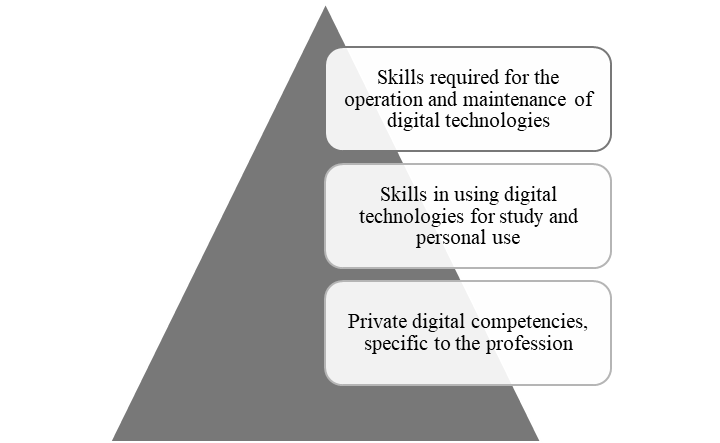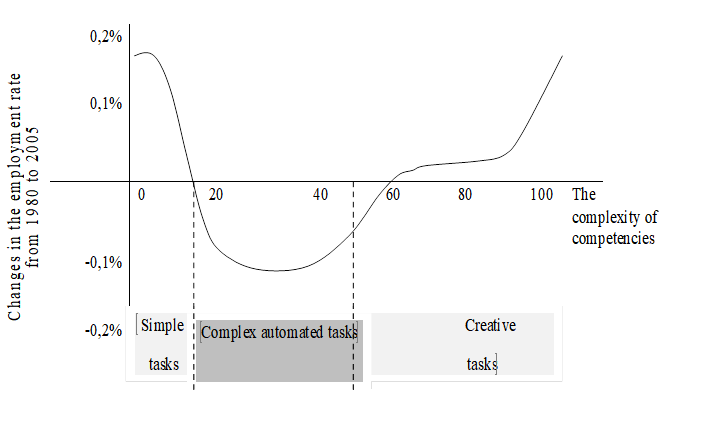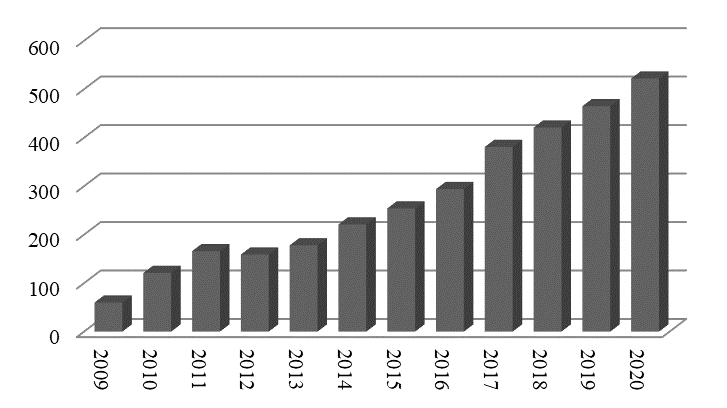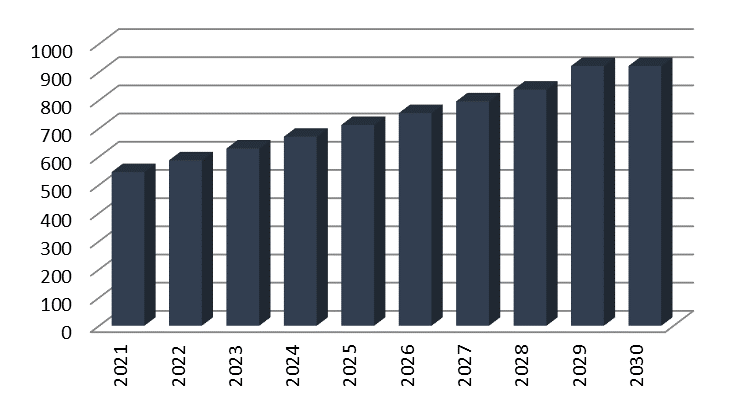Abstract
The fourth industrial revolution and the transition to the digital economy are transforming social and industrial relations and creating demand for a new competence profile. A significant part of the world's economically active population is worried about losing their jobs due to the spread of digital technologies and freelancing. The aim of the paper is to clarify the prospects of shifting basic competencies in the developing digital economy. Researchers are following the theory of evolutionary economics and the concept of changing technological orders. The authors formulated the concept of digital competencies based on the review and integration of existing scientific approaches. Digital competence is the result of a complex integration of abilities, skills and knowledge that contributes to the accumulation of experience, the implementation of professional skills and labor competencies in a digital environment. Digital competencies are knowledge of the digital space of a certain professional activity, skills and abilities to work with digital technologies. The proposed concepts are a contribution to the theoretical discussion in this area. The research based on foresight and regression-correlation analysis and provides key trends in the transition to the digital economy, positive dynamics of the level of robotization, and the shift of competencies towards digital competencies. Labor functions are replaced by a bionic management model based on combining digital technologies and algorithms with exclusively human abilities for creativity, reflection, and empathy. The research has practical significance for adapting educational programs and training personnel for the digital economy.
Keywords: Digital competencies, digital economy, fourth industrial revolution, foresight, digital transformation, digital accounting
Introduction
The impact of the fourth industrial revolution and digital transformation actualizes the need to expand the list of new competencies for life and professional development in a digital society (Frey & Osborne, 2017). The digital economy creates a demand for specialists with special digital competencies (Prainsack, 2020), a deep understanding of their field of activity, as well as knowledge and experience in related fields (Machlup, 2016). AI and robotics are displacing or at least more effectively replacing manual and logic labor.
These reasons determine the relevance of this research.
Problem Statement
Digital technologies are fundamentally transforming production processes and economic relations. Key forms of transformation of operations in the process of production, promotion and sale include:
1. Informatization (providing employees with data and replacing physical objects with digital ones, for example, switching from paper to electronic document),
2. Automation (providing the employee with processed data and performing standardized, routine functions automatically by digital tools, for example, accounting automation systems allow to automate the entry of primary documentation and reporting to regulatory authorities),
3. Robotization (replacing human labor with cyberphysical systems from simple physical processes to making intelligent robots (artificial intelligence) independent decisions based on data-technologies).
Digitalization is characterized by working with a large array of data in the digital space and involving agents in interaction in an ecosystem, as well as the desire to exclude the human factor from processes. 61% of the global population expressed concern about too rapid technological development in 2019 (Edelman Trust Barometer 2020, 2020).
Digitalization covers all areas of activity and requires mastering the skills of working with digital technologies not only for IT specialists and engineers, but also for all other areas, from working professions to lawyers and civil servants.
Research Questions
There are many definitions of the concept of "digital competence". Researchers (Bell, 1974; Clayton, 2011; Daniel et al., 2015) called its main components: critical thinking, emotional intelligence, adaptability, ability to work in conditions of uncertainty, ability to continue education. These components form the framework of digital competence that allows you to successfully use digital technologies in your life.
Many terms describe this concept, for example, computer literacy (competence), information competence, digital literacy, etc. (Hurlebaus et al., 2011; Jeong et al., 2013; Tahmasebi, 2015). Two main approaches to understanding digital competencies are American and European.
According to the American approach, competencies are defined as a description of employee behavior in a digital environment, when the employee with the appropriate competencies demonstrates the correct behavior and achieves the desired results in their work (Zhu et al., 2016). The European approach focuses on the employee's ability to solve certain tasks in order to achieve results in accordance with the requirements and standards defined in the organization (Jeong et al., 2013).
Russian researchers (Dneprovskaya et al., 2018; Malushko et al., 2016; Noskova, 2016) adhere to the approach that digital competencies are a system of knowledge, skills, and abilities that are required when using information and communication. Digital competencies include abilities and skills that allow a person to navigate the digital knowledge society and receive education throughout life (Politsinskaya et al., 2019). Existing approaches to understanding digital competencies are integrating into Russian practice due to the functioning of a large number of multinational companies and the completion of the transition of professional education from the assessment of knowledge, skills and abilities to the assessment of competencies.
Purpose of the Study
The aim of the work is to clarify the prospects for shifting basic competencies in the developing digital economy. A set of tasks for achievement the aim included:
- To establish the content of the concept of digital competencies;
- To identify a list of widespread and potentially demand digital technologies;
- To evaluate the pace of industrial robotization;
- To identify trends in changing competencies, including those related to the robotization factor.
Research Methods
Researchers work within the framework of evolutionary theory (Nelson & Winter, 1982) and the concepts of cyclical economic development (Kondratiev, 1935), technological orders (Glazyev, 2009) and the 4th industrial revolution (Schwab, 2017).
Using system-structural analysis and foresight identified key trends related to the transition to the digital economy. The dynamics of individual characteristics was determined by regression and correlation analysis.
The authors rely on the following conceptual framework in this study. Digital competence is the result of a complex integration of abilities, skills and knowledge that contributes to the accumulation of experience, the implementation of professional skills and labor competencies in a digital environment. Digital competencies, or the competencies of a digital economy specialist, are knowledge of the digital space of a certain professional activity, skills and abilities to work with digital technologies.
Findings
Digital competencies include three basic components (Figure 1). Basic digital competencies imply typical, most widespread and necessary for a wide range of specialties. Knowledge about the digital space of a certain professional activity includes ideas about digital platforms and ecosystems of interaction between various parties in the relevant field, about information and databases stored on digital media, and about digital technologies used in work.

The authors consider the concept of digital competencies not only as the sum of general user and professional knowledge and skills that are represented in various models, but also as a set for accumulating additional skills that ensure life and professional development in the digital environment. We define digital competence as the continuous mastery of digital competencies and ability of individual to choose and apply digital technologies in various spheres of life confidently, effectively, critically and safely.
Transformations affect different professions and their replacement or elimination. For example, an accountant is a suitable profession (Skolkovo, 2019), where an alternative process will eventually replace its current labor functions with a bionic management model that supports accounting processes using algorithms, typing accounting operations, accounting documents, accounting policies, and digital identification of all participants and contractors. The technological singularity is the reality of the coming centuries if we take into account the speed of discovery and innovation. They are delayed in modern realities by a number of subject-object differences in the specifics, conditions, resource factors and technology levels of states. The adequacy of adaptation to the transformation process can only be a competent choice and development of digital competencies, skills, knowledge that form the T-competence of most employees (soft-skills) and to a lesser extent the ML – competence (machine learning ) of employees. Figure 2 shows the Autor curve based on statistics on the demand for professions in the form of a relationship between employment and skill level (complexity of competencies) according to US industry data for the period from 1980 to 2005.

We distinguish a pattern (in the conditions of developed industries of state economies) of changing positions of dependent variables (employment and competencies) under the influence of transformation mechanisms (task automation) in the presented Autor curve. We can distinguish an even more complex approach of transformational fluctuations (fluctuations are caused by the period of formation of the core of the sixth technological order) in the digital economy. In addition to the automation process, other areas of hi-tech and bionic model formation are added:
1) Web 2.0, cloud technologies, mobile technologies, ERP, BRM, CRM, PDA platforms
2) Big data, analytics, visualization, blockchain
3) Internet of things, smart machine, machine learning, digital shadows
4) Artificial intelligence (AI), robotization.
The author concluded that the dynamism of the speed of transformation will increase with the development of these areas, their active implementation in the processes of human life and digital technological diffusion of all areas in order to create new synergistic effects.
Table 1 contains an analysis of the dynamics of the growth rate and technology structure based on data from the World economic forum (WEF, 2018) relative to the base year (2020).
The analysis confirms our hypothesis about the acceleration of technologies in the formation of the core of the sixth technological order.
The calculation shows major changes in the digital world. The result for the previous 20 years shows an increase in digital technological diffusion by almost 1.7 times. We highlight the growth over the next 10 years in 3 times. AI takes special place in this growth, because it can most quickly replace many complex automated professional tasks. The functional core of the sixth technological order will be more stable and influential where AI, neural networks of artificial consciousness, and robotization will develop more intensively. Figure 1 provides information on the dynamics and volume of the robotics market in the world (International Federation of Robotics, 2019).

The general regression and correlation analysis determined the regression dependence and tightness of the correlation (R-square = 0.96804) in the linear model:
(1)
Yi- is the target indicator of the function corresponding to the number of industrial robots;
Хi - period of the forecast assessment of the state in the research.
Figure 3 reflects the forecast of the dynamics and volume of the robotics market in the world.

Formula 1 with its generalized character and a high deviation leads to the conclusion. Increasing the number of industrial robots at the current rate of growth will give 712.4 thousand units in the world by 2025, and 921.5 thousand units by 2030. We understand that for a deeper and more objective forecast, it is necessary to increase the selection of factors. However, it should be noted that the increasing trend is obvious.
Conclusion
The digital technological revolution will lead to an even greater stratification of people based on knowledge and access to information. Traditional ways to reduce social inequality (Akhmadullin et al., 2020) will not work in the digital world.
According to the Edelman Trust Barometer 2020 (Edelman…, 2020), 83% of employees in the world are afraid of losing their jobs, the biggest fear is the development of gig-economy and freelancing - 61% of respondents, 53% are afraid of automation. 49% and 34% of employed people in Russia are afraid of these reasons. Russians see the greatest threat in the looming recession (60%) (Edelman Trust Barometer 2020, 2020). This may indicate that digitalization processes in Russia are lagging behind global trends.
Russian educational programs at various levels are still focused on the development of traditional competencies without including elements of digital technologies in training programs.
Adaptation of educational programs to the needs of the digital economy faces the problem of determining the list of basic digital competencies. The results of this research can become the basis for correcting the educational programs of general and higher education, as well as organizing retraining of specialists in the digital economy to meet the demand for personnel and the new industrialization.
References
Akhmadullin, I. R., Safina, A. V., & Fatkhullina, L. Z. (2020). Potential to Mitigate Social Inequality Through Individuals Taxation Reform. Advances in Economics, Business and Management Research, 128, 3129-3133. DOI:
Bell, D. (1974). The Coming of the Post-industrial Society: A Venture in Social Forecasting. Penguin.
Clayton, N. (2011). Business Joins the Party – Social Media: Online. Wall Street Journal. http://www. wsj.com/articles/SB10001424052748703712504576244622146113118
Daniel, J., Vázquez Cano, E., & Gisbert, M. (2015). The Future of MOOCs: Adaptive Learning or Business Model? Universities and Knowledge Society Journal, 12(1), 64-73.
Dneprovskaya, N. A., Urintsov, A., & Afanasiev, M. (2018). Study the Innovative Environment of the Digital Economy. Proceedings of the 15th International Conference on Intellectual Capital, Knowledge Management & Organizational Learning, 1, 67–76.
Edelman Trust Barometer 2020. (2020). https://cdn2.hubspot.net/hubfs/440941/Trust%20Barometer%202020/2020%20Edelman%20Trust%20Barometer%20Global%20Report.pdf?utm_campaign=Global:%20Trust%20Barometer%202020&utm_source=Website
Frey, C. B., & Osborne, M. A. (2017). The Future of Employment: How Susceptible are Jobs to Computerization? Technological Forecasting and Social Change, 114, 254-280.
Glazyev, S. Yu. (2009). The global economic crisis as a process of changing technological structures. Economic Issues, 3, 26-38. DOI:
Hurlebaus, S., Stocks, T., & Ozbulut, O. E. (2011). Smart Structures in Engineering Education. Journal of Professional Issues in Engineering Education & Practice, 138(1), 86-94.
International Federation of Robotics. (2019). IFR World Robotics Presentation. https://ifr.org/downloads/press2018/IFR World Robotics Presentation - 18 Sept 2019.pdf
Jeong, J. A., Kim, M., & Yoo, K.-H. (2013). Content Oriented Smart Education System based on Cloud Computing. International Journal of Multimedia and Ubiquitous Engineering, 8(6), 313-328. DOI:
Kondratiev, N. D. (1935). The Long Waves in Economic Life. The Review of Economics and Statistics, (6), 105-115.
Machlup, F. (2016). Knowledge: Its Creation, Distribution and Economic Significance. In: The Economics of Information and Human Capital. Princeton University Press.
Malushko, E., Maletina, O., Lizunkov, V., & Tsybaneva, V. (2016). Use of virtual learning system for educating students with disabilities and special needs. International Multidisciplinary Scientific Conferences on Social Sciences and Arts, 481-487.
Nelson, R., & Winter, S. (1982). An Evolutionary Theory of Economic Change. Belknap Press of Harvard University Press.
Noskova, T. (2016). Modern education quality requirements and information technologies in academic teachers’ activities. International Journal of Continuing Engineering Education and Life-Long Learning, 26(4), 434-459. DOI:
Politsinskaya, E., Lizunkov, V., & Ergunova, O. (2019). Organization of student project based activities through individual learning routes. International Journal of Emerging Technologies in Learning, 14(11), 186-193.
Prainsack, B. (2020). The political economy of digital data: introduction to the special issue. Policy Studies, 41(5), 439-446. DOI:
Schwab, K. (2017). The Fourth Industrial Revolution. Crown Business.
Skolkovo. (2019). Atlas of new professions-almanac of promising industries and professions for the next 15-20 years. http://atlas100.ru/
Tahmasebi, J. S. (2015). Gompertz-power Series Distributions. Communications in Statistics – Theory and Methods, 45(13), 3761-3781.
WEF. (2018). Digital Transformation Initiative. Unlocking $100 Trillion for Business and Society from Digital Transformation. Executive summary. https://reports.weforum.org/digital-transformation/wp-content/blogs.dir/94/mp/files/pages/files/dti-executive-summary-20180510.pdf
Zhu, Z. T., Yu, M. H., & Riezebos, P. (2016). A research framework of smart education. Smart learning environments, 3(1), 1-17.
Copyright information

This work is licensed under a Creative Commons Attribution-NonCommercial-NoDerivatives 4.0 International License.
About this article
Publication Date
21 June 2021
Article Doi
eBook ISBN
978-1-80296-110-2
Publisher
European Publisher
Volume
111
Print ISBN (optional)
-
Edition Number
1st Edition
Pages
1-1168
Subjects
Social sciences, education and psychology, technology and education, economics and law, interdisciplinary sciences
Cite this article as:
Blizkiy, R. S., Rakhmeeva, I. I., & Ergunova, O. T. (2021). Prospects Of Shifting Basic Competencies In The Digital Economy. In N. G. Bogachenko (Ed.), Amurcon 2020: International Scientific Conference, vol 111. European Proceedings of Social and Behavioural Sciences (pp. 764-772). European Publisher. https://doi.org/10.15405/epsbs.2021.06.03.102

